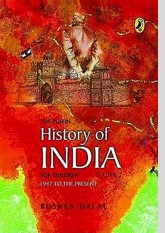The Puffin History of India for Children, Volume 2: 1947 to Present
The companion volume to the best-selling Puffin History of India for Children: 3000 BC – AD 1947, Roshen Dalal’s new history of post-Independence India tells the story of the making of the nation that we live in, and the events and personalities that have shaped it in recent times.The Puffin History of India for Children: 1947 to the Present begins at a turning point of Indian history, as India attains independence and the British withdraw from the subcontinent. Independent India’s first few years are eventful and epoch-making: before the traumas of Partition and of the assassination of Mahatma Gandhi have fully subsided, the focus must shift to laying the blueprint of the new nation, with the making of the Constitution, the integration of the 565 princely states, the setting-up of the administrative, legislative and judiciary systems, and the establishment of an infrastructure for industry and agriculture. The author follows this key period in Indian history closely, from the first Republic Day celebrations in 1950 to the first general elections in 1952, and the implementation of the subsequent agendas for social and economic development envisaged by Jawaharlal Nehru.In a lucid and informal style, the book then tells the fascinating story of India over the next fifty years, beginning with the premierships of Nehru, Lal Bahadur Shastri and Indira Gandhi and proceeding to Jayaprakash Narayan and the Emergency, the ousting of the Congress party and the rule of the Janata government headed by Morarji Desai. The author describes the dramatic turnarounds of the 1980s and ’90s, from Indira Gandhi’s return to power to her subsequent assassination, Rajiv Gandhi’s prime ministership, the governments of V.P. Singh and P.V. Narasimha Rao, and the Bharatiya Janata Party’s rise to power, with Atal Bihari Vajpayee heading a National Democratic Alliance government. Along with periods of growth, the book looks closely at times of turbulence: the Indo-China War of 1962, the war with Pakistan in 1965, the 1971 Bangladesh War, and the demolition of the Babri Masjid in 1992. It also analyses some issues that are key to the recent history of the nation: economic liberalization, the harmful effects of terrorism and sectarian movements on the national fabric, the Kargil conflict, India’s attainment of nuclear capability and its progress into the new millennium as the world’s largest democracy.This is not merely a political history of India. It tells the story of India’s people—from an account of the social and economic changes that have taken place since Independence, to art and culture in independent India. Colourful descriptions, informative nuggets and lively analyses make the book immensely readable. An attractive layout, profuse illustrations, detailed maps and a thorough index add to its value. A long chapter outlines the history of each individual state and union territory, full of information that will be invaluable to the student as well as the casual browser.Well-researched, concise, unbiased and engaging, this is a contemporary history of India that should be essential reading for children of all ages.

